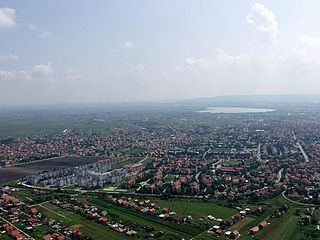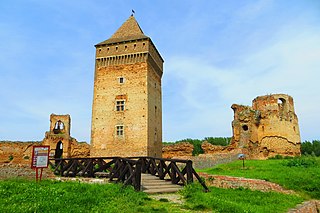
Zemun is a municipality of the city of Belgrade. Zemun was a separate town that was absorbed into Belgrade in 1934. It lies on the right bank of the Danube river, upstream from downtown Belgrade. The development of New Belgrade in the late 20th century expanded the continuous urban area of Belgrade and merged it with Zemun.

The Hilandar Monastery is one of the twenty Eastern Orthodox monasteries in Mount Athos in Greece and the only Serbian monastery there. It was founded in 1198 by Stefan Nemanja and his son Saint Sava. St. Symeon was the former Grand Prince of Serbia (1166-1196) who upon relinquishing his throne took monastic vows and became an ordinary monk. He joined his son Saint Sava who was already in Mount Athos and who later became the first Archbishop of Serbia. Upon its foundation, the monastery became a focal point of the Serbian religious and cultural life, as well as "the first Serbian university". It is ranked fourth in the Athonite hierarchy of 20 sovereign monasteries. The Mother of God through her Icon of the Three Hands (Trojeručica), is considered the monastery's abbess.

Borča is an urban settlement of the municipality of Palilula, Belgrade, Serbia. As of 2011, it has a population of 46,086 inhabitants.

Smederevo is a city and the administrative center of the Podunavlje District in eastern Serbia. It is situated on the right bank of the Danube, about 45 kilometres downstream of the Serbian capital, Belgrade.
Palilula is a municipality of the city of Belgrade. It has the largest area of all municipalities of Belgrade. The core of Palilula is close to the center of the city, but the municipality also includes sparsely populated land left of the Danube.

Irig is a town and municipality located in the Srem District of the autonomous province of Vojvodina, Serbia. The town has a population of 4,415, while Irig municipality has 10,866 inhabitants.

Fruška gora is a mountain in Syrmia, administratively part of Serbia with a part of its western side extending into eastern Croatia. The area under Serbian administration forms the country's oldest national park. Sometimes it's also referred to as the Jewel of Serbia, due to its largely pristine landscape and protection effort, or the Serbian Mount Athos, it being the home of a large number of historical Serbian Orthodox monasteries.

Bač is a town and municipality located in the South Bačka District of the autonomous province of Vojvodina, Serbia. The town has a population of 5,399, while Bač municipality has 14,405 inhabitants. The entire geographical region between the rivers Danube and Tisza, today divided between Serbia and Hungary, was named Bačka after the town.

Novi Bečej is a town and municipality located in the Central Banat District of the autonomous province of Vojvodina, Serbia. The town has a population of 13,133, while Novi Bečej municipality has 23,925 inhabitants.

Ovča is a suburban settlement of Belgrade, the capital of Serbia. It is located to the northeast of the city, in the municipality of Palilula.

Crna Trava is a village and municipality located in the Jablanica District of southern Serbia. According to 2011 census, the population of the village is 434 inhabitants, while population of the municipality is 1,663. This is the smallest by population and poorest municipality in Serbia.

The Fenek Monastery is the male monastery in the eparchy of Srem of the Serbian Orthodox Church. The monastery is situated near the village of Јаkovo, 25 km from Belgrade, former Municipality of Zemun and now Surčin. Although geographically it does not belong to Fruška gora there is a huge historical connection with Fruška gora monasteries. The monastery church was dedicated to St. Martyr Paraskeva.

The Golubac Fortress was a medieval fortified town on the south side of the Danube River, 4 km (2.5 mi) downstream from the modern-day town of Golubac, Serbia. According to recent discoveries, the fortress, which was built during the 14th century by Medieval Serbian state, is split into three compounds which were built in stages. It has ten towers, most of which started square, and several of which received many-sided reinforcements with the advent of firearms. Towers were not connected for easier defense. Also inside the fortress were found Serbian Medieval frescos.

Pančevački Rit is a small geographical area in south-western Banat, Serbia. It is situated between the rivers Danube and Tamiš, in Belgrade's municipality of Palilula.
Karaburma is an urban neighborhood of the municipality of Palilula, Belgrade, Serbia. As of 2002, it has a population of 55,343 inhabitants.

Kovilovo is a suburban settlement of Belgrade, the capital of Serbia. It is located in the Belgrade's municipality of Palilula.

Serbia's capital city of Belgrade is divided into 17 municipalities.
Veliko Selo is a suburban settlement of Belgrade, Serbia. It is located in the Belgrade's municipality of Palilula.

Gardoš is an urban neighborhood of Belgrade, the capital of Serbia. It is located in Belgrade's municipality of Zemun. Located on the slopes of the hill of the same name, with its tower and preserved old architecture, Gardoš is the major historical landmark of Zemun. Remnants of the Gardoš Fortress, built in the 14th century and the 15th century, are the oldest surviving parts of Zemun.

Kosmaj is a mountain south of Belgrade, the capital of Serbia. With an elevation of 626 meters, it is the highest point of the entire Belgrade City area and is nicknamed one of two "Belgrade mountains".

















